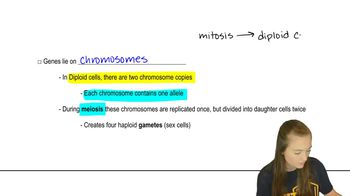True or False:For conjugation to occur, bacterial cells must physically contact each other.
Table of contents
- 1. Introduction to Genetics51m
- 2. Mendel's Laws of Inheritance3h 37m
- 3. Extensions to Mendelian Inheritance2h 41m
- 4. Genetic Mapping and Linkage2h 28m
- 5. Genetics of Bacteria and Viruses1h 21m
- 6. Chromosomal Variation1h 48m
- 7. DNA and Chromosome Structure56m
- 8. DNA Replication1h 10m
- 9. Mitosis and Meiosis1h 34m
- 10. Transcription1h 0m
- 11. Translation58m
- 12. Gene Regulation in Prokaryotes1h 19m
- 13. Gene Regulation in Eukaryotes44m
- 14. Genetic Control of Development44m
- 15. Genomes and Genomics1h 50m
- 16. Transposable Elements47m
- 17. Mutation, Repair, and Recombination1h 6m
- 18. Molecular Genetic Tools19m
- 19. Cancer Genetics29m
- 20. Quantitative Genetics1h 26m
- 21. Population Genetics50m
- 22. Evolutionary Genetics29m
5. Genetics of Bacteria and Viruses
Bacterial Conjugation
Problem 1f
Textbook Question
For bacteria that are F⁺, Hfr, F', and F⁻, perform or answer the following.
Describe a "partial diploid" and how it originates.
 Verified step by step guidance
Verified step by step guidance1
Define the term 'partial diploid': A partial diploid, also known as a merozygote, is a bacterial cell that contains two copies of a specific gene or set of genes. This occurs when a fragment of DNA is introduced into a bacterial cell that already has its own chromosomal DNA.
Explain how a partial diploid originates in F' bacteria: In F' bacteria, the F plasmid (fertility plasmid) carries a segment of chromosomal DNA due to an imprecise excision event from the bacterial chromosome. When this F' plasmid is transferred to an F⁻ recipient cell during conjugation, the recipient cell becomes a partial diploid for the genes carried on the plasmid.
Describe the role of conjugation: Conjugation is the process by which genetic material is transferred from one bacterial cell to another through direct contact. In the case of F' bacteria, the F' plasmid is transferred to the recipient cell, introducing a second copy of the genes carried on the plasmid.
Discuss the genetic implications: The recipient cell now has two copies of the genes carried on the F' plasmid—one on its original chromosome and one on the plasmid. This allows for the study of gene expression, dominance, and complementation in bacteria.
Summarize the significance: Partial diploids are important tools in bacterial genetics as they enable researchers to study the function of specific genes and their interactions in a controlled manner.
 Verified video answer for a similar problem:
Verified video answer for a similar problem:This video solution was recommended by our tutors as helpful for the problem above
Video duration:
4mPlay a video:
Was this helpful?
Key Concepts
Here are the essential concepts you must grasp in order to answer the question correctly.
Partial Diploid
A partial diploid is a bacterial cell that contains two copies of a specific segment of its genome, typically due to the presence of an extra piece of DNA. This can occur when a bacterium takes up a plasmid or a fragment of chromosomal DNA from another bacterium through horizontal gene transfer, resulting in a cell that has two alleles for certain genes.
Recommended video:
Guided course

Diploid Genetics
Horizontal Gene Transfer
Horizontal gene transfer (HGT) is the process by which bacteria exchange genetic material with one another, rather than inheriting it from parent cells. This can occur through mechanisms such as transformation, transduction, or conjugation, allowing for genetic diversity and the acquisition of new traits, such as antibiotic resistance.
Recommended video:
Guided course

Mapping Genes
Conjugation
Conjugation is a form of horizontal gene transfer in bacteria where genetic material is transferred from one bacterium to another through direct contact. This process often involves the transfer of plasmids, which can carry genes that confer advantageous traits, such as fertility factors (F factors) that facilitate the formation of partial diploids when F⁺ or Hfr strains interact with F⁻ strains.
Recommended video:
Guided course

Conjugation Overview
Related Videos
Related Practice
Multiple Choice
705
views
3
rank


